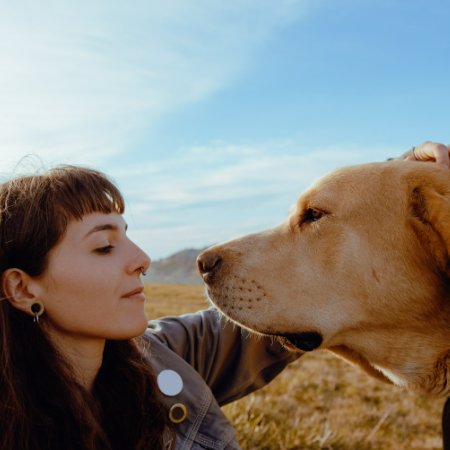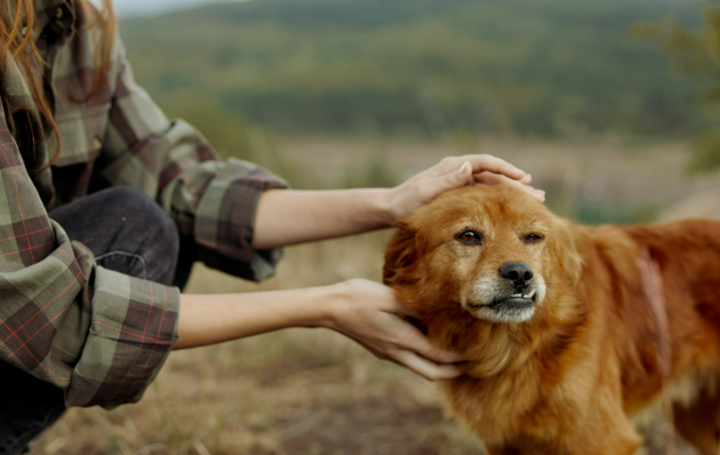How Dogs Can Help Detect Human Emotions: The Science Behind Canine Empathy
Like their wagging tails and nose nudges, many dog owners believe that dogs are able to detect human emotions. Whether we are happy, sad, anxious, or excited, our dogs always seem to be able to tell. Are we projecting our own feelings onto our pets, or is there science underlying this instinct?
Using a combination of body language, scent, and empathy, research is increasingly demonstrating that dogs can accurately interpret human emotions. To discover how much our dogs connect with us, let’s explore the intriguing field of canine empathy.
The Evolutionary Bond: Why Dogs Understand Us So Well
Dogs and humans have had a special and enduring affinity for thousands of years. Given that canines with superior emotional intelligence had a higher probability of surviving, some experts think this link is evolutionary. It’s possible that early dogs that reacted to nonverbal cues from people were fed, housed, and protected. Dogs today appear to have a unique ability to sense our emotions, and this mutualistic relationship has continued to develop.

According to research, dogs are one of the few non-human animals that use eye contact to communicate with people. They closely observe our body language, speech tones, and facial emotions. For instance, research published in Animal Cognition showed that dogs were able to distinguish between faces that were furious and those that were cheerful. When presented with the option, the study’s trained dogs consistently selected the cheerful face. The ability of dogs to identify and react well to human emotions is demonstrated by this behavior, which has probably been developed over many generations of friendship.
Understanding Emotions Through Scent: Dogs and the Power of Smell
Being able to “smell” our emotions is one of the most intriguing features of canine emotion detection. Dogs’ olfactory systems are significantly more advanced than ours; they have up to 300 million scent receptors, whereas humans only have 5–6 million. In order to comprehend the world around them, including the emotional moods of their human companions, dogs deconstruct complicated chemical compounds to “read” scents.
Our bodies emit minute chemical cues called chemosignals when we feel emotions like tension, fear, or joy. These cues might range from pheromones to variations in body odor brought on by fluctuating hormone levels. According to studies, dogs are able to recognize these changes and even respond to them. Sweat samples from humans in a variety of emotional states, including tension, fear, and happiness, were given to dogs in one experiment. Happy scents caused dogs to behave in a relaxed and amiable manner, while frightened scents caused them to exhibit signs of anxiety and elevated heart rates.
The reason dogs are frequently utilized as therapy animals for individuals with anxiety or PTSD is due to the power of scent. They can sense when someone is tense or nervous, and they frequently offer consolation by being there. It’s almost as if these canines can “smell” emotions with their extremely sensitive noses and then react with empathy.
The Canine Brain and Human Connection
More understanding of what goes on inside our furry pals’ brains has been made possible by recent developments in neuroscience. Dogs’ MRI scans have allowed researchers to see the areas of the dog’s brain that react to human voices, emotions, and even specific words. They discovered that when a dog hears a joyful tone or a well-known praise, their brains light up. The caudate nucleus, a region linked to reward anticipation and good emotions, is the area that illuminates.
Furthermore, the sounds and tones of human voices are very sensitive to dogs’ brains. Dogs can distinguish between joyful and sad noises, and they react to these differences with varied behaviors. This vocal sensitivity contributes to the special emotional bond we have with our dogs. When you speak in a soothing tone, your dog may tilt their head or perk up their ears, just like a best friend, indicating that they are completely focused on comprehending you.
Empathy vs. Sympathy: Are Dogs Really Empathetic?
Dogs can perceive our emotions, according to the data, but the question of whether they are genuinely sympathetic still needs to be answered. Do they “feel” what we do, or are they just responding in a conditioned way?
The capacity to both identify and experience another person’s feelings is known as empathy in humans. Dogs have a more complicated situation. One research at London’s Goldsmiths University investigated this by watching how dogs behaved when people feigned tears or other signs of distress. Not only did the study’s canines approach the sobbing people, but they also did so in a soothing and tranquil manner—more so than when the same people were merely humming or conversing.

Although dogs may not have the same capacity for empathy as humans, the researchers found that they do have a type of “emotional contagion” that enables them to react to other people’s feelings in a reassuring manner.
Dogs appear to sincerely care about the feelings of their people, whether this is an innate behavior or a learned one. Some experts contend that although dogs might not be able to comprehend the complexities of human emotions, they are able to recognize cues and signals, which causes them to react in ways that are similar to empathy.
Dogs and Therapy: How Canines Are Changing Lives
The ability of dogs to sense human emotions has many practical uses. Therapy dogs are being utilized to assist in lowering stress and enhancing mental health in schools, nursing homes, and hospitals. They assist warriors suffering from PTSD, children with autism, and even patients undergoing challenging medical procedures. Therapy dogs can help people control their emotions by detecting when they are worried or anxious. Their soothing presence reduces blood pressure and produces endorphins.
Children who struggle with reading can also benefit from therapy dogs through programs like Reading with Rover. It is simpler for kids who are uncomfortable reading aloud to adults to read to dogs since they are reassuring and nonjudgmental. In these situations, dogs serve as a safe haven for kids to develop their reading abilities by offering them company as well as emotional support.
How You Can Strengthen Your Emotional Bond with Your Dog
Developing a close emotional bond with your dog improves their capacity to recognize and react to your feelings. These pointers will help you develop this relationship:
Maintain eye contact: Although it might occasionally feel frightening to humans, eye contact fosters connection and trust in dogs. Spend a few minutes every day gently and non-threateningly gazing into your dog’s eyes. According to studies, eye contact can deepen your bond by raising oxytocin levels in both humans and dogs.

Be Consistent with Tone: Dogs can detect spoken tones quite well. When you communicate with your dog, use a soothing, upbeat tone to help them connect you with warmth and security.
Practice Physical Affection: A gentle ear scratch or belly rub can make a big impact. In addition to providing your dog with comfort, physical contact also generates oxytocin, which benefits both of you.
Practice Mindful Time Together: Spend time together with mindfulness by playing games, taking walks, or simply lounging next to one another. You can better comprehend each other’s cycles and fortify your shared emotional landscape by making time for each other.
The Special Role Dogs Play in Our Emotional Lives
Even while science can explain a lot of the mechanics underlying dogs’ emotional sensitivity, having a dog who “gets you” is more than just a biological reaction. Dogs are born with the capacity to bring us joy, support us through difficult times, and establish an inexplicable bond with us. They may never be able to completely comprehend our feelings, yet they react with a kind of mystical empathy.
Remember that your dog isn’t just there because they’re a habit the next time you’re feeling a little gloomy. They want to be there for you because they feel something. Dogs show us that sometimes the best treatment comes on four paws by helping us manage life’s ups and downs in their own special manner.
Doglime for more dog-related information.
Tags










